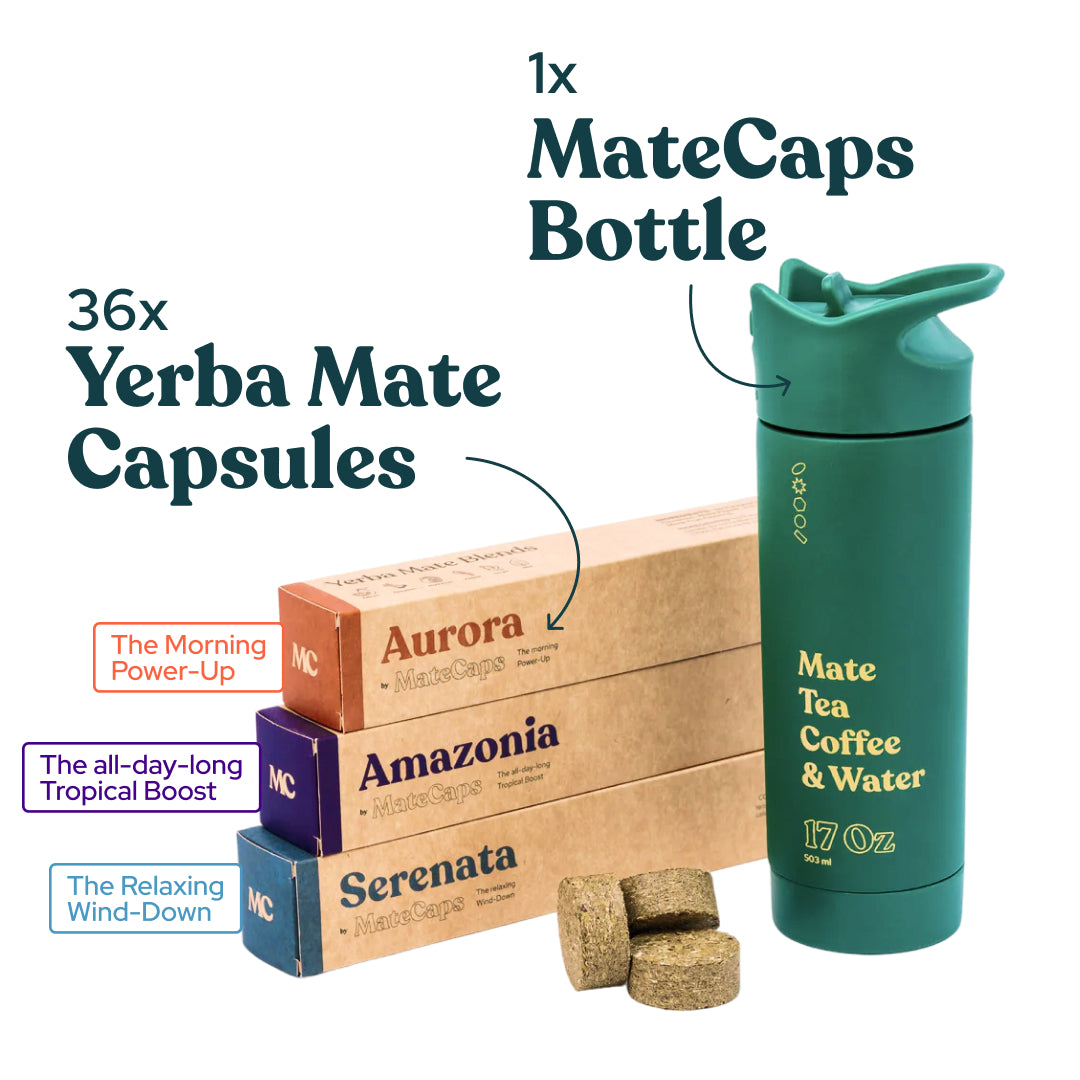
Yerba Mate: Natural Energy and Ritual
Yerba mate is a traditional South American infusion prized for clean, steady energy and ritual drinking. ☕️ It’s an appealing alternative for people seeking less jittery stimulation than coffee but more kick than herbal tea. This guide explains what yerba mate is, how it works, and how to use it safely and sustainably.
What is yerba mate?
Yerba mate comes from the leaves of Ilex paraguariensis. People in Argentina, Uruguay, Paraguay and southern Brazil have brewed it for centuries. It’s consumed as a hot infusion from a gourd with a metal straw (bombilla), as cold mate (tereré), or in modern forms like bags, bottled drinks, and capsules.
Why people choose yerba mate
- Steady mental clarity without the crash. ⚡️
- Nutrient-rich profile: polyphenols, xanthines, and vitamins. 🌿
- Social ritual: associated with community and mindfulness.
Many modern consumers want a natural energy option that supports focus and mood. Yerba mate delivers both stimulation and a sense of calm alertness.
Key compounds: what’s inside yerba mate?
Yerba mate contains a mix of stimulants and antioxidants:
- Caffeine — provides energy and alertness.
- Theobromine and theophylline — milder stimulants that support a gentle, sustained lift.
- Polyphenols and flavonoids — antioxidants that may support metabolic and cardiovascular health.
Research into metabolic effects and glycaemic control has been growing. A recent systematic review highlights yerba mate’s potential to affect glycaemic control and metabolic markers, though more rigorous trials are still needed to confirm long-term benefits for humans (Frontiers in Endocrinology, 2025).
Yerba mate vs. coffee and energy drinks
- Onset & duration: Yerba mate often feels smoother than coffee, with fewer spikes. Less jitter.
- Nutrient content: Contains antioxidants that typical energy drinks lack. Better for sustained focus.
- Additives: Many energy drinks have sugar and synthetic stimulants. Yerba mate is naturally derived.
If you want caffeine without the crash, yerba mate is a strong contender. It offers stimulation plus beneficial plant compounds.
Health benefits supported by evidence
Research is evolving. Here are areas where scientific and clinical reviews suggest benefits:
- Metabolic and glycaemic effects: Systematic reviews suggest potential improvements in glycaemic control and markers of metabolic health, though study quality varies and larger trials are needed (Frontiers in Endocrinology, 2025).
- Appetite and weight management: Some consumer-focused analyses indicate yerba mate may help curb appetite and support modest weight loss when combined with diet and exercise (HUM Nutrition blog).
- Antioxidant activity: Yerba mate’s polyphenols can fight oxidative stress in lab studies, which may translate to long-term health effects when consumed regularly.
These findings are promising. But remember: no single food or drink is a magic bullet for health.
Safety, cancer concerns, and what the research says
Concerns have been raised about very hot mate and cancer risk. Reviews indicate that high-temperature consumption of any beverage can increase esophageal cancer risk. Studies specifically on mate and cancer have mixed results, and experts urge caution with temperature rather than demonizing the plant itself. For balanced discussion see the review notes at Food for Breast Cancer which explains that studies have not established a causal effect of yerba mate on breast cancer and highlights gaps in research.
General safety pointers:
- Avoid extremely hot brews. Let it cool slightly. 🔥➡️🌡️
- Limit intake if you are sensitive to caffeine, pregnant, breastfeeding, or taking stimulant medications.
- Check interactions if you take medications for blood pressure, blood thinning, or certain psychiatric drugs.
How to prepare yerba mate (traditional and modern)
Traditional hot mate
- Fill a gourd one-third to half with yerba.
- Tilt the gourd so leaves form a slope.
- Pour cool water to moisten leaves, then add hot water (not boiling), 70–80°C (160–175°F).
- Sip through a bombilla. Refill several times.
Tereré (cold brew)
- Ideal for hot weather. Use cold water or herbal infusions.
- Refreshing and gentle on the stomach.
Tea bags, French press, and cold-brew
- Use 1–2 teaspoons per cup. Steep 3–5 minutes for hot tea; 6–12 hours for cold-brew in the fridge.
- Cold-brew yields smoother flavor and milder caffeine.
Capsules and ready-to-drink forms
- Provide convenience and controlled dosing. They’re helpful for on-the-go routines and for people who dislike the ritual or taste.
Practical tips: get the best experience
- Start low: If you’re new to stimulants, try half a cup first. 🌱
- Watch timing: Avoid late-evening consumption to protect sleep.
- Blend wisely: Citrus peels, mint, or ginger pair well with mate.
- Store properly: Keep leaves dry and away from direct sunlight.
Sustainability and the yerba mate industry
Sustainability is a growing concern. The yerba mate supply chain includes farming, processing, and packaging. Opportunities exist to reduce waste and improve circularity across the industry. A review in the Journal of the Science of Food and Agriculture highlights these circular economy opportunities and recommends strategies for sustainable production and resource use in the yerba mate sector (Journal of the Science of Food and Agriculture, Wiley).
Buying from brands that prioritize ethical sourcing and sustainable packaging can make a difference for communities where mate is cultivated.
Trends and social stories
Yerba mate has seen a resurgence in modern wellness circles. From micro-influencer posts to cold-brew recipes, the plant is getting attention on social platforms. For example, community and fitness-driven content on platforms like Lemon8 shows how people incorporate mate into active lifestyles. 📱🔥
Cultural context and rituals
Sharing mate is a social ritual in South America. It’s about conversation, pause, and community. Ritual drinking is a global theme — many cultures maintain distinct communal beverages. For perspective on how ritual and community shape beverage traditions, see other cultural examples like the Druze and their communal practices (Wikipedia: Druze).
Who should avoid or limit yerba mate?
- People with caffeine sensitivity. 😬
- Pregnant or breastfeeding people should consult a clinician.
- Those with certain health conditions or medication regimens should seek medical advice.
Choosing a quality yerba mate product
- Look for organic or low-pesticide options.
- Seek transparent sourcing and full-leaf products (less dust, better flavor).
- If sustainability matters to you, check for certifications or company disclosures on ecological practices.
Testimonials & social proof
"I switched from afternoon coffee to mate and feel calmer but focused. No jitters." — Maria, 34 📸
"Tereré is my summer go-to. Hydrating and energizing." — Alex, 27 📸
"Capsules make it easy to get consistent doses before workouts." — Jordan, 41 📸
(Visuals: lifestyle photos of mate, gourd shots, cold-brew bottles.)
Quick reference: brewing temps and dosage
- Hot mate: 70–80°C (160–175°F)
- Cold-brew: 6–12 hours in fridge
- Typical cup: 1–2 teaspoons per 8 oz
- Traditional gourd: refill 5–10 times
Bottom line
Yerba mate provides a unique mix of steady energy, antioxidants, and cultural ritual. The science shows promise for metabolic and glycaemic effects, while safety considerations center on drink temperature and caffeine sensitivity. Sustainability and product quality matter — and the industry is moving toward more circular practices.
If you’re curious about incorporating yerba mate into daily life, explore forms that match your routine: traditional gourd, cold-brew, tea bags, or convenient capsules.
Conclusion
Yerba mate is more than a stimulant. It’s a botanical with cultural roots, measurable bioactive compounds, and real potential for supporting focus and metabolic health when used thoughtfully. For people who value convenience and clean energy, modern formats like standardized capsules can simplify dosing and reduce preparation time. Learn how a convenient format can fit your lifestyle at MateCaps: https://matecaps.com — they focus on accessible, standardized ways to experience yerba mate without losing sight of origin and quality.
Frequently Asked Questions
What is yerba mate and how does it differ from coffee?
Yerba mate is an infusion made from the leaves of Ilex paraguariensis commonly consumed in Argentina, Uruguay, Paraguay and southern Brazil. It contains caffeine, theobromine, and polyphenols. Compared with coffee, mate often produces a smoother, less jittery energy because it combines caffeine with theobromine and other compounds that moderate stimulation. Mate also contains antioxidants and micronutrients that typical coffee lacks. Preparation varies—traditional mate is sipped from a gourd through a bombilla, while modern options include tea bags, cold-brew, bottled drinks, or capsules. Individual responses vary, so start with small amounts if you're sensitive to stimulants.
Is yerba mate safe to drink every day?
For most healthy adults, moderate yerba mate consumption is generally safe. However, caution is recommended. High-temperature beverage consumption has been linked to increased esophageal cancer risk, so avoid drinking extremely hot mate. People sensitive to caffeine should limit intake, and pregnant or breastfeeding individuals should consult a healthcare provider. Drug interactions are possible with medications for blood pressure, anticoagulants, and stimulant-sensitive psychiatric drugs. The evidence base is growing: recent systematic reviews indicate potential metabolic benefits but also highlight the need for more large-scale human trials to establish long-term safety and efficacy.
Can yerba mate help with weight loss or appetite control?
Some studies and consumer-focused analyses suggest yerba mate may support modest weight loss and appetite suppression when combined with a healthy diet and exercise. Compounds in mate can enhance metabolic rate and influence satiety signals in the short term, according to nutrition experts. However, mate is not a standalone solution for weight loss—consistent lifestyle changes remain essential. Evidence quality varies, and researchers call for larger, controlled human trials to clarify the magnitude and consistency of these effects.
How should I brew yerba mate for the best results?
Traditional hot mate is brewed in a gourd with a bombilla: fill the gourd one-third to half with yerba, tilt to form a slope, moisten with cool water, then add hot water (70–80°C / 160–175°F). For a smoother flavor and lower caffeine extraction, try cold-brew by steeping leaves in the fridge for 6–12 hours. Tea bags and French press methods work too—use 1–2 teaspoons per cup and steep 3–5 minutes for hot tea. Adjust strength and steep time to your taste and caffeine sensitivity.
Are there sustainability concerns with yerba mate production?
Yes. The yerba mate supply chain includes cultivation, processing, and packaging stages that affect ecosystems and local communities. Sustainability issues include pesticide use, soil management, water resources, and packaging waste. Reviews in agricultural journals highlight circular economy opportunities in the yerba mate industry and recommend strategies to reduce waste and improve resource efficiency. When possible, choose products with transparent sourcing, organic certifications, or company commitments to sustainable farming and fair labor practices.
Can I take yerba mate in capsule form instead of brewing it?
Yes—capsules offer a convenient, standardized option for people who want consistent dosing without the ritual of brewing. Capsules can be helpful for pre-workout routines or when traveling. Make sure you choose products with clear labeling on caffeine content and sourcing. Capsules don’t provide the social ritual of shared mate, but they retain many of the active compounds found in loose-leaf mate. If you have medical conditions or take medications, consult a healthcare professional before starting any supplement.
